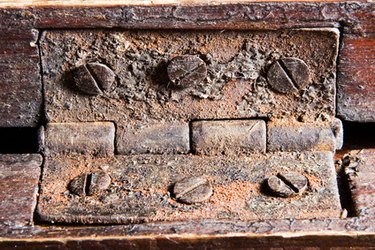
A full mortise hinge is a plate hinge designed to have one or both leaves mortised into the door and the cabinet face or door jamb. The hinge sits flush with the surface of the door and frame when installed, leaving a smooth finished appearance. Fitting a full mortise hinge requires skill and attention to detail to ensure that the hardware fits properly and the door is fully functional.
Why Mortise a Hinge?
Video of the Day
The mortised hinge will give the cleanest final appearance when used on a door for a cabinet or a room. Mortising the hinge into the face frame or jamb and the door creates a tighter fit between the door and the frame. The tighter the fit, the more professional the finished job will appear. The inset cut for the hinge also holds the hardware captive so it does not move under the stress of door movement.
Video of the Day
Mortising a Hinge
The mortise for a hinge can be done with a router and a straight bit or a knife and a chisel. Both approaches begin by laying a leaf of the hinge on the surface of the door or jamb. Trace around the hinge and mark the centers of the screw holes. Cutting the mortise using either a power or hand tool must be done with caution. The mortise cannot be deeper than the thickness of the hinge plate and it must be square to the edge of the jamb or face.
Advantages of a Mortised Hinge
Other than the appearance of the final hardware installation, there are other advantages to mortising a hinge. For example, the edges of the hinge leaf are held secure within the wood of the door or cabinet face, preventing the hinge plates from twisting out of alignment under the weight of the door and loose screws.
Disadvantages of a Mortised Hinge
A disadvantage of selecting a mortised hinge style is the additional work and precision needed for the installation. A non-mortised hinge sits on the surface of the door and face or jamb and is easily adjusted by re-drilling the mounting holes if it is out of alignment. The mortised hinge that is incorrectly located would need the mortise to be filled, sanded, and then recut to fix any mistakes in the original installation.
European Cup Hinges
A popular style of mortised hinges is the European cup hinge. The mortise is circular and is cut with a hole saw. The advantage of this hinge is that you can make adjustments without moving the hinge in its mortise once mounted.